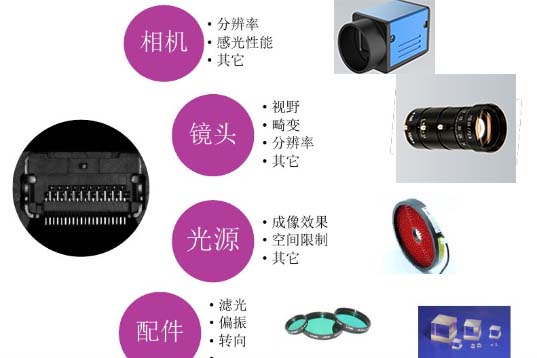Shenzhen Dehong Vision Technology Co., Ltd.
Phone: 137 2892 0823
Fax: 0755-2372-6873
Email: 908450505@qq.com
Website: www.dhkj123.com
en.dhkj123.com
Address: Goldman Sachs Building, No. 18 Shajing
Center Road, Baoan District, Shenzhen
To analyze the unstable factors of machine vision, we must first understand what is the imaging system of machine vision.
What is an imaging system for machine vision?
The imaging system is mainly composed of industrial cameras (CCD / CMOS), lenses and visual light sources. It is the basis of visual inspection. The design purpose of the imaging system is to obtain the original images of qualified inspection objects, and a good imaging system must ensure the system The image quality is stable during operation, and stable image capture is the basic guarantee for the stability of visual inspection.
What are the instability factors of machine vision imaging systems?
1.Influence of industrial cameras on imaging stability
For vision system designers, the choice of an industrial camera is mainly based on its sensor type, resolution, and frame rate. Among them, the sensor is divided into CCD and CMOS. CMOS image sensors are highly integrated, and the distance between components and circuits is very close. The interference is serious, and the imaging noise is high. Compared with CMOS cameras, CCD sensor cameras have the characteristics of high sensitivity, low noise, and fast response speed. In terms of stability, CCD cameras are also more resistant to shock and vibration. Generally speaking, CCD cameras Sensor cameras are superior to CCD cameras in terms of imaging quality and stability.
2.The influence of optical lens on imaging stability
In addition to the need to select appropriate parameters such as focal length, depth of field, and aperture according to the specific working conditions, the important factor affecting the detection accuracy of the system is the geometric distortion error of the image. It is an inherent perspective distortion of optical lenses. It is affected by the production process and cannot be eliminated. I can only think of ways to reduce it. Although many industrial cameras now make up for errors caused by lens distortion through various methods, in the field of high-precision detection, geometric distortion still affects the detection accuracy.

The impact of vision hardware on the vision system
3.Impact of light source on imaging stability
The light source has the effect of highlighting the characteristics and defects of the image, which directly affects the quality of the input data. Since there is no universal lighting equipment, lighting is also a difficulty of the machine vision system. Usually, it is not only necessary to select the type of light source for each specific application In addition, the installation of the light source and the illumination method of the light source should be tested according to the specific environment to achieve the best imaging effect. There are differences in the stability of different types of light sources, non-uniformity of the light sources will also affect the image quality, and differences in the luminous intensity in different directions will also cause noise.
4.Influencing factors of software stability
The impact of the stability of the vision detection software on the results of machine vision detection is also very important. The vision system will eventually use the software to perform a series of image processing such as image filtering, edge detection and edge extraction on the computer using different algorithms. Different images Processing and analysis methods as well as different detection methods and calculation formulas will bring different errors, and the quality of the algorithm determines the level of measurement accuracy.
5. Environmental factors
Vision system working environment factors include ambient temperature, light intensity, power supply voltage, dust, humidity, and electromagnetic interference. A good operating environment is the guarantee for the normal operation of the vision system. The external light will affect the illuminance on the measured object, increase the noise of image data output, and the change of the power supply voltage will also cause the light source to emit light instability and generate noise that changes with time. Temperature changes will also affect the performance of the camera. The camera will mark the normal temperature range when it leaves the factory. Overheating or coldness will affect the normal operation of the camera. Electromagnetic interference is an inevitable interference factor on the industrial testing site. It has a particularly serious impact on weak current circuits such as industrial camera circuits and data signal transmission circuits. Qualified vision products will undergo strict anti-interference tests at the factory, which greatly reduces Impact of external electromagnetic interference on hardware circuits.
6.Influencing factors of mechanical structure positioning
In addition to the imaging system hardware, the relative positional relationship between the camera and the object will also affect the stability of the image quality. For example, if there is vibration in the mechanical support structure of the camera or workpiece, it will affect the detection accuracy, and it is also difficult to check problem. When detecting a workpiece under dynamic conditions, the effect of motion blur on image accuracy needs to be considered (blurred pixels = object motion speed * camera exposure time). Between the CCD camera and the tested part, the optical axis of the camera lens should be perpendicular to the plane where the part is located in a rational state. However, in actual use, due to installation errors or camera and workpiece manufacturing errors, the optical axis cannot be completely perpendicular to the measured plane There is a certain angular deviation, which will also affect the measurement accuracy.
Solutions to ensure system stability
I have mentioned some problems about the unstable factors. Is there any way to reduce these unstable factors? Of course there are, please see the methods and suggestions below.
1. Hardware selection and scheme design
The hardware selection of the imaging system is particularly important. According to the above analysis of CCD cameras and CMOS cameras, it can be known that if there are no special requirements, such as high imaging speed (CMOS has a faster readout speed), CCD sensor cameras ensure image quality and The primary choice for stability. The resolution and frame rate of the camera are mainly selected according to the detection accuracy and detection speed. The appropriate resolution is determined by calculating the size of the field of view of the detected object and the distance between the camera and the measured object. The speed and accuracy of the measurement of the object requires the selection of the camera's frame rate.
For the lens, it is necessary to select the corresponding lens resolution according to the camera's limit resolution, and select a camera that is larger than the camera's limit resolution. It is also necessary to calculate the focal length of the lens according to the working distance and field of view, and according to the measured object and the camera. Select the appropriate depth of field for distance changes. Under high-precision measurement, to ensure measurement accuracy, in addition to the correct selection of the above parameters, you can choose a telecentric lens with small geometric distortion compared to ordinary lenses. A telecentric lens not only has less geometric distortion, but also reduces the change in object distance. Bring errors.

Work flow chart of machine vision system
2. Calibration
Industrial cameras and lenses will always cause more or less geometric distortion errors in the original image acquired due to the process. This error cannot be completely eliminated by hardware optimization, but calibration software algorithms can be used to reduce this error. The effect of accuracy, the basic principle of camera calibration is to obtain the internal and external parameters and distortion parameters of the camera through the camera's shooting of standard images (usually using calibration plates) at different angles in the field of view, and establish a mapping relationship between 3D coordinates and image coordinates In order to correct the original distorted image, usually camera calibration must be used in measurement and positioning with accuracy requirements.
3.Choose the right algorithm
The original image collected by the hardware must finally pass the algorithms such as graph filtering and edge detection to complete the detection function and realize the output of the detection result. Among them, image filtering can suppress the noise existing in the collected images, reduce the problem of unstable light sources and gray values, and improve the signal-to-noise ratio. The essence of the algorithm is to ensure that the minimum variance between pixels on the image is the smallest. For high-precision measurement systems, the coarse-level pixel-level accuracy is often difficult to meet the requirements. The sub-pixel-level edge positioning technology can combine the subdivision algorithm and the fitting method at the pixel-level position to make the edge position reach sub-pixel-level accuracy of 0.1 or even 0.01. , The system detection accuracy is guaranteed.
to sum up
To sum up, the design of the machine vision system needs to consider many factors. In addition to selecting the visual accessories with the corresponding parameters according to the general selection parameters according to the needs, the stability of the light source, the distortion error of the camera, and the detected Factors such as relative motion between the object and the camera bring stability interference and measurement errors to the detection system. Only by comprehensively considering these factors to optimize the design of the vision system can a stable and qualified machine vision inspection system be established.

attention
Shenzhen Dehong Vision Technology Co., Ltd.
Phone: 137 2892 0823
Fax: 0755-2372-6873
Email: 908450505@qq.com
Website: en.dhkj123.com
Address: 19th Floor, Goldman Sachs Building,
No. 18 Shajing Center Road, Baoan District, Shenzhen
